It’s not often that we review a product that’s nearly 22 months into its life cycle, but we’re making an exception for the BenQ W1070. Since launch back in December 2012, this little 3D DLP projector has been selling well, largely owing to its very affordable price of £699 (or even lower if you scour around on the internet). Does it perform well enough to provide big-screen thrills, or is it a case of you get what you pay for? Let’s find out.
The first thing that struck us upon unpacking the BenQ W1070 was how light and small the unit is compared with other home theatre projectors we’ve tested to date, taking up a footprint no larger than a 13-inch laptop. The lens is offset to the left, and there are manual, cross-interacting zoom and focus rings which need readjustment every time you twist the supplied lens cap on and off.
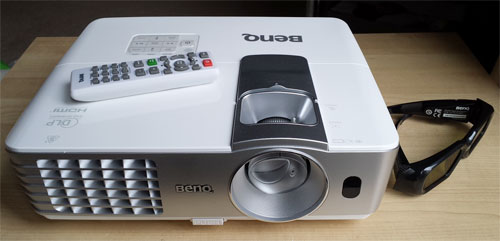
A vertical lens shift control is available under a sliding panel on top of the chassis. Although adjustments require the use of a screwdriver, and its range is fairly limited, we’re pleased to see the inclusion of such a feature which – together with an extendable jack at the front plus an adjustable foot at the rear left – goes some way towards avoiding keystone correction and the resolution loss it entails.
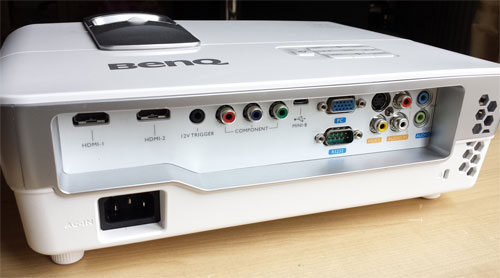
The connection inputs (including two HDMI ports) and power inlet are found at the rear of the projector. The front exhaust vents to the right of the lens leak a fair amount of light, so careful placement is crucial to prevent distracting contamination. Build quality is acceptable considering its budget price point.
Our W1070 review sample calibrated beautifully – BenQ has implemented calibration controls which are well laid-out and work as they should. We engaged the most accurate out-of-the-box picture preset – “Cinema” – and proceeded the calibrate the W1070 with a profiled Klein K10-A, DVDO AVLab TPG signal generator and CalMAN 5.3 video calibration software, with measurements taken off our projector screen.
Four [Colour Temperature] settings are available, namely “Cool“, “Normal“, “Warm” and “Lamp Native“, but in [Cinema] mode you can’t change the setting unless you turn on [Brilliant Color] – fortunately the new setting will then stay even after you disable [Brilliant Color]. As it turned out, the default [Colour Temperature] value of “Normal” was the least inaccurate among the four:
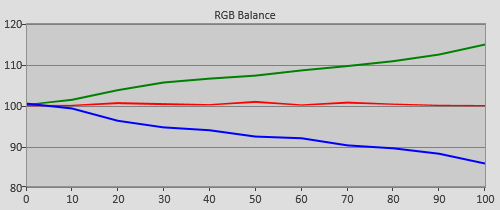 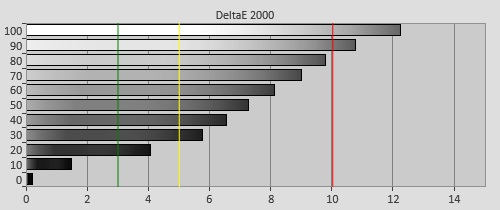 |
| Pre-calibration RGB tracking and delta errors (dEs) |
Still, there’s plenty of room for improvement. Using the included two-point white balance controls (found under the [Color Temperature Fine Tuning] submenu), we dialled out the excess green and underfilled blue components:
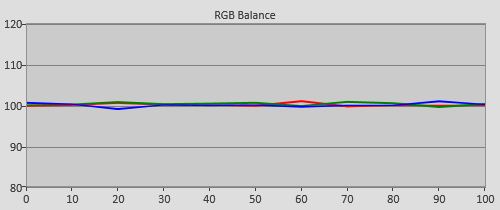 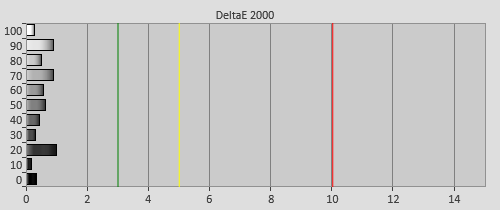 |
| Post-calibration RGB tracking and dEs in [Cinema] mode |
Despite the absence of 10-point white balance controls, it took no effort for us to get greyscale to track closely to D65, with delta errors (dEs) running comfortably under the widely acceptable visible threshold of 3, meaning that the projected image should look tint-free throughout the luminance range.
A [Gamma] setting of “2.4” yielded a measured overall gamma of 2.4 on our setup. BenQ hasn’t provided a 10-point gamma system, but there exist no less than 9 presets from “1.8” all the way up to “2.8“, which you can use to shift the (mostly flat) gamma tracking up or down should you find shadow detail and midtones to be too bright or dark.
![Pre-calibrated Gamma tracking in [Cinema] mode](https://www.hdtvtest.co.uk/news/wp-content/uploads/2018/04/projector_BenQ-W1070_pre-gamma.png) | ![Post-calibrated Gamma tracking in [Cinema] mode](https://www.hdtvtest.co.uk/news/wp-content/uploads/2018/04/projector_BenQ-W1070_post-gamma.png) |
| Pre-calibration gamma tracking (2.43) | Post-calibration gamma tracking (2.41) |
The [Colour Management] system on the BenQ W1070 is well-implemented, allowing calibration of hue, saturation and luminance (labelled as [Gain]) for all six primary (red, green, blue) and secondary (cyan, magenta, yellow) colours, although occasionally the native gamut may limit any further adjustment in spite of available room in the slider controls.
![Post-calibration Colour saturation tracking in [Cinema] mode](https://www.hdtvtest.co.uk/news/wp-content/uploads/2018/04/projector_BenQ-W1070_post-strack.jpg) |
| Post-calibration colour saturation tracking |
Nevertheless, we achieved an excellent result, with delta errors (dEs) curbed under the humanly perceptible cutoff of 3 across all the measured colour saturation tracking points with decoding taken into account.
![Post-calibration colour errors in [Cinema] mode](https://www.hdtvtest.co.uk/news/wp-content/uploads/2018/04/projector_BenQ-W1070_post-strack-de.png) |
| Post-calibration colour errors (<3 not appreciable to the eye) |
| Dead pixels | None |
| Panel uniformity | Some unevenness, not visible in real-life content |
| Primary chromaticity | Good |
| Motion resolution | 300 lines |
| Digital noise reduction | Defeatable |
| Sharpness | Defeatable |
| 1080p/24 capability | No judder in 2D and 3D |
| Input lag (Led Bodnar tester) | 33ms |
We spun a few of our favourite Blu-rays, and were highly impressed by the BenQ W1070’s bold and realistic colours, with flesh tones and foliage – two memory colours where we can spot errors from a mile away – never looking out of place. The single-chip DLP design meant that sharpness was adequately maintained, imbuing the on-screen picture with plenty of texture and detail. We didn’t witness any rainbow effect (RBE) from the onboard 6x colour wheel, though those who are particularly susceptible to this phenomenon may wish to check one out in person with a copy of Sin City before committing.
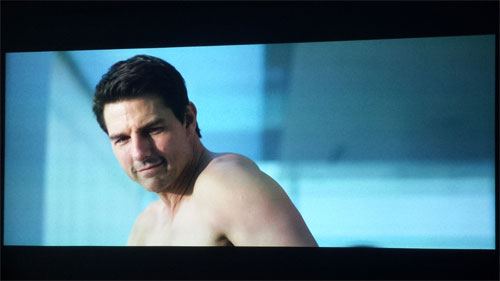
Black level was only average rather than good, but to get significantly deeper blacks that can elevate your enjoyment to another level, you’d probably have to spend three times as much on a Sony VPL-HW40ES. A dynamic iris (DI) system might have helped in this department, but then again it would likely push the price up, and introduce “light pumping” artefacts. The BenQ W1070 doesn’t pass blacker-than-black (BTW) and whiter-than-white (WTW) data, so there were times when we found shadow detail wanting. However, in the grand scheme of things, and in view of the projector’s bargain basement price, these issues rarely bothered us as we drank in the lovely images being projected on screen.
The W1070’s tri-dimensional performance was so fantastic that we’re somewhat disappointed that BenQ doesn’t ship any 3D glasses with the projector, because many owners will be missing out since they have to go out and buy a pair to watch 3D. If you think watching Gravity on your [insert TV model number here] is good, wait till you see it on the W1070 – the immersive, crosstalk-free extra-dimensional experience blown up onto a big screen was truly something else.
BenQ loaned us two types of active-shutter 3D glasses to go with our review sample: the first a chunky, thick pair which is non-rechargeable; and a later, updated version that’s lighter and rechargeable. We never got either to work – the chunky pair failed to sync, and rechargeable pair refused to hold charge. What worked really well for us was a pair of A1114 DLP-Link glasses from 3D3, which synced first time and gave a sufficiently bright 3-D picture (we measured a maximum of 35 cd/m2 through the shuttering lens) that remained well-saturated even during low-light scenes. The darkening effect of the active-shutter glasses did its part in lowering the black floor, adding punch to the 3D image.

Gamers who’d like to enjoy some big-screen gaming action will be well-served by the W1070: we clocked an input lag of 33ms using a Leo Bodnar tester, which should translate to fluid responsiveness for playing video games.
If you’re looking for an affordable ticket to enjoy movies on the big screen in the comfort of your own home, then you could do far worse than the BenQ W1070. And if you manage to get it calibrated, we don’t think there’s any better alternative at this price point.
